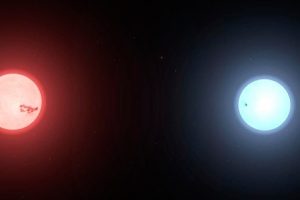The magnetic activity vs. age in binary systems with a white dwarf and a main sequence star. The study: “Main-sequence companions to white dwarfs – II. The age-activity-rotation relation from a sample of Gaia common proper motion pairs” of A. Rebassa-Mansergas (Universitat Politècnica de Catalunya) recently appeared on MNRAS

Several stellar phenomena and evolutionary processes are connected to their magnetic fields. The mechanisms that allow stars to produce their magnetic fields depend on their internal structure and stellar properties. One dominant property is stellar rotation: the faster stars rotate, the more intense their magnetic field and magnetic activity. Since stellar rotation declines with age, it is not surprising that stellar magnetic activity also declines with age.
The relationships between the possible diagnostics probing stellar magnetic activity and stellar age are actually quite complicated, as they depend on various stellar properties, such as the convective overturn timescale (which represents a typical timescale for convective transport in stars) and their overall evolution, particularly the efficiency of magnetic braking due to angular momentum loss. From an observational point, one of the complications is the typical difficulty in constraining stellar ages with currently available techniques.
The team led by the astronomer A. Rebassa-Mansergas (Universitat Politècnica de Catalunya) analyzed the magnetic activity of a specific sample of stars for which it is possible to constrain the age: binary systems with a low-mass main-sequence star and a white dwarf. By considering certain properties of the white dwarf, such as its mass and cooling timescale, it is indeed possible to derive the age of the white dwarf and consequently that of its stellar companion. The studied sample consists of 662 binary systems with available spectroscopic observations, providing crucial diagnostics for probing stellar magnetic activity. Among the stars in this sample, except for those in close binary systems, magnetic activity is absent in stars older than 5 billion years. In younger stars, the fraction with intense magnetic activity varies between 10% and 40%, depending on several stellar properties. A few stars exhibit very intense magnetic activity for their ages, likely due to less efficient angular momentum loss through magnetic braking. Future surveys, such as the one scheduled with the 4MOST telescope starting in 2024, will yield larger samples of such binary systems (approximately 2500), enabling the extension of these studies. This research is described in the paper titled “Main-sequence companions to white dwarfs – II. The age-activity-rotation relation from a sample of Gaia common proper motion pairs“, recently published in “The Monthly Notices of the Royal Astronomical Society”. Among the coauthors is J. Maldonado from INAF – Astronomical Observatory of Palermo.
The figure (click here to visualize it entirely) shows as artistic view of a binary system with a low mass star and a white dwarf.
Mario Giuseppe Guarcello ( follow mariospiegacose) ( mariospiegacose) ( follow mariospiegacose)
Follow the Astronomical Observatory of Palermo on Facebok and on Instagram
Subscribe the Youtube channel of the Astronomical Observatory of Palermo
